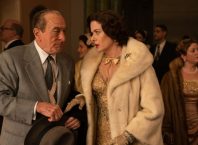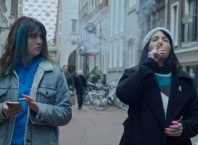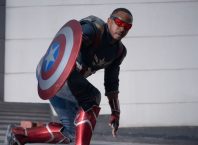“How do you film a nightmare? Probably the best way is by animation,” commented Thomas White, Editor of Documentary Magazine. White and documentary filmmaker Marshall Curry, who were in Israel as part of The American Documentary Showcase, had walked past the location of the nightmare scene in “Waltz with Bashir”, spurring a discussion on the aesthetics of documentary filmmaking. Says Curry, “I’m not a purist, I love animation, voice over, verité…I just wonder if you took the same movie, and instead of animating it, shot it with actors, would people say it is a documentary? I don’t think so.”
Curry’s “street cred” as someone who watched a lot of movies, read a lot of books, bought a camera and set out the next day to make his first documentary, meshes well with the scholarly passion White conveys for his field. Informing me that the first use of animation in documentary goes as far back as “Lusitania” made in 1919, White says, “There’s always been a conscious need to tell a story and employ narrative devices, it needn’t exude the pejorative elements that those who are not in the documentary community append to documentaries that they are boring, talking heads. It’s a very dynamic art form.”
It is perhaps this dynamic quality that led the US Department of State to initiate The American Documentary Showcase as a way to present the diverse and changing face of America to the world, one screening at a time. 29 movies have been selected which will be shown in 60 countries. White and Curry spent a whirlwind week in Israel from May 8 – 15, showing and discussing several documentaries, including Curry’s first film “Street Fight” (nominated for an Academy Award in 2005) in Sderot, Taibeh, Jerusalem, Nazareth and Tel Aviv.
Curry expressed his surprise that “Street Fight” was selected as one of the movies in the showcase, saying, “It’s not necessarily the side of American democracy you want people to see.” The movie follows the 2002 race for mayor of Newark, NJ between four-term incumbent Sharpe James and post-civil rights era, Yale educated Corey Booker. As far from “talking heads” as a movie can be, moving between political intrigue and action movie as Curry’s camera and crew are at times physically barred from filming. The movie exposes not only the erosion of political integrity in James’ thirty-odd year reign over Newark, but the racial tensions between black candidates of different eras and world views.
Curry and White both expressed the view that showing the more complex, if less complimentary aspects of America can enhance communication with other countries. Rather than viewing America as a monolithic collection of Hollywood plastic perfection, “airing the dirty laundry” as Curry puts it, presents a more accurate portrayal. As for “Street Fight”, Curry feels it communicates that “politics doesn’t work all the time. People make mistakes, they pick the wrong guy…the coda of the movie is – you can change it. You think the stories are specific American, but they are universal.” After a screening at the Ma’ale film school in Jerusalem, a student commented that the tensions within the black community depicted in the film reminded her of the conflicts between Sephardic and Ashkenazi Jews in Israel.
At a screening which took place in Tel Aviv for the Israeli Forum of Documentary Filmmakers, White and Curry talked about the film and answered questions, many of which related to the difficulties of making, funding and marketing documentaries. One audience member commented in Hebrew that Curry “sets a bad example for students” because he did not formally study filmmaking. However, a look at his background reveals a road perhaps “less travelled by” but no less compelling. After completing
Comparative literature studies at Swarthmore Curry lived in Mexico for a year where he taught English and did a lot of reading. Considering teaching as a possible vocation, he moved to Washington D.C. where he worked in a program that brought high school students to the capital to learn about democracy from members of congress and journalists. A fellowship in Indiana where he researched the economics of non-profits led to his interest in organizations such as PBS (Public Broadcasting Service) and although the job ended, he “stuck around for the summer helping someone who was making an historical documentary”. At that point in the narrative, the various threads of comparative thinking, education, democracy, and film came together and Curry began to work in New York for a company that made interactive documentaries for museums.
Reflecting on his past Curry says, “I always loved documentaries and watched a lot of them and wanted to make them. None of the friends I grew up with made documentaries; it was hard to take the leap…My parents don’t do that, they don’t get that really…Everyone in my family does finance. I’d saved up some money – I decided to try to make a movie.” Although he attributes some of the success of his first film to luck, “stuff that happened [in the campaign]…I didn’t know it was going to happen. If six of those scenes hadn’t happened the movie would be totally different,” he also notes: “The other side [of not going to film school] –I was there a lot and I worked really really really hard…I spent months of physically and emotionally very hard work. I came home after shooting and looked at the footage and tried to figure out how I wanted it to look. Looked through books to figure out how to construct it, how a scene was cut together. As someone said – the harder I work the luckier I get.”
When asked if he had intentionally provoked the several “action scenes” where the mayor’s people and even the police try to take away his camera, Curry said, “I wasn’t…I was always nervous, hoping I could just shoot the thing that I wanted to shoot. I don’t really like confrontation, I’m averse to confrontation. [there is a] sense of justice that pushes me – what they were doing was wrong, and I wasn’t going to let them get away with doing something wrong.”
Curry’s second film, “Racing Dreams” is about a completely different topic – three teenagers who dream of being NASCAR racers, and another film that relates to environmental issues is currently in process. Commenting on the diversity of his subject matter, Curry said, “They’re pretty different… [but they have] something in common –
They’re about people who want something.”
Image credit: Marshall Curry Productions, LLC





